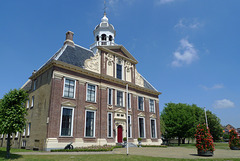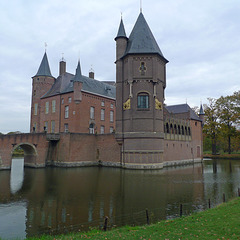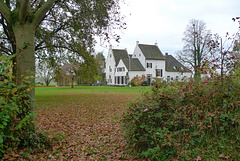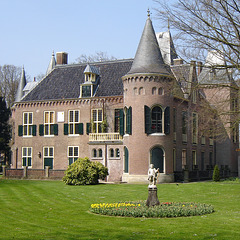
Nederland: kastelen en buitenplaatsen
Folder: Nederland - the Netherlands
Foto's van Nederlandse kastelen, landhuizen, havezathe's en buitenplaatsen.
Nederland - Heerenveen, Crackstate
| |
|
|
|
Most probably the first ‘state’ was built in the year of 1608 by a member of the Crack-family. On the same spot the present stately house was built in 1648 by Johannes Sytzes Crack, ‘grietman (a kind of mayor) of Aengwirden’. Architect was Willem de Keyser, son of the famous Dutch architect Hendrick de Keyser. The face of the building therefore has some similarity with the houses along the canals of Amsterdam.
The building is surrounded by a moat. The bridge over the water dates - as specified on a bricked stone - from 1775. The port for the bridge comes away from the Frisian village of Horn and mentions the year 1819.
Up to 1833 the house was the residence of the Crack family, when it became a public building, used as a court-house. From 1952 Crackstate is part of the town hall of the municipality of Heerenveen. It is located nearby the town centre.
Nederland - Heerenveen, Crackstate
| |
|
|
|
Most probably the first state (residential manor) was built in the year of 1599. On the same spot the present stately house was built in 1647/48 by Johannes Sytzes Crack, grietman (a kind of mayor) of Aengwirden’. Architect was Willem de Keyser, son of the famous Dutch architect Hendrick de Keyser. The face of the building therefore has some similarity with the houses along the canals of Amsterdam.
The building is surrounded by a moat. The bridge over the water dates - as specified on a bricked stone - from 1775. The port for the bridge comes away from the town of Horn and mentions the year 1819.
Up to 1833 the house was the residence of the Crack family, when it became a public building, used as a court-house. Crackstate was a very notorious place during World War II, when it was used for torturing and executing people.
From 1952 Crackstate is part of the town hall of the municipality of Heerenveen. It is located nearby the town centre.
Nederland - Kasteel Heeswijk
| |
|
|
|
Kasteel Heeswijk (Heeswijk Castle) was originally built around 1080 by inhabitants of the valley of the river Aa as a motte, a moated refuge.’Count Almericus van Heeswijk’ ís the first (1156) known castle dweller. In the 13th century the castle becomes the property of the family ‘Van Bentheim’, who enlarged the castle at the end of that century.
In subsequent years, the castle had several owners and it was rebuilt and expanded many times. In 1834 Belgian ‘André baron van den Bogaerde van Terbruggen’ bought Heeswijk Castle and of course it was rebuilt again. He and his descendants were art collectors and decorated the castle with all kinds of art and the castle was partly used as a museum; its nickname was ‘Musée de Bogaerde’.
The last noble descendant died in 1994 and since that time the castle is owned by The Heeswijk Castle Foundation. Nowadays the castle, gatehouse and coach house are used for cultural activities and/or are housing a café, restaurant and conference rooms. The castle can be visited during a guided tour, while the garden and surrounding park are free of charge.
Nederland - Heeswijk-Dinther, Huis Zwanenburg
| |
|
|
|
‘Huis Zwanenburg’ (Manor Zwanenburg) is the only remaining manor of the six medieval fortified houses which once stood in Dinther. It was built in several stages. Around the year of 1400 a so called ‘steenen kaemer’ (stone room) was built on the site of the current manor. Such a stone room was not meant for permanent residence, but served as a shelter for the owner of the estate, when he came to Zwanenburg consulting his tenants and managing the estate.
The part of the building with the gabled roof is probably built between 1500 and 1520. In the 17th century the house was extended and at the end of that century radically rebuilt. In 1733 the house was completely dilapidated, but later it was restored. Around1950 a major restoration followed and the manor became its current look.
‘Huis Zwanenburg’ is picturesquely situated in the valley of the river Aa between Dinther and Veghel and is located in the hamlet Beugt.
Nederland - Heerlen, Kasteel TerWorm
| |
|
|
|
Kasteel TerWorm or Ter Worm (Ter Worm Castle) was inhabited by noble families since the 14th century. The first known owner was the Lord of Strijthagen in 1476, when the castle was a moated building fortified by external walls outside the moat. The castle was destroyed by fire in 1550 but rebuilt in the same style. The rebuilding, completed by the Van Wijlre family, was done in brick and the building was painted white to disguise the difference in building materials. The castle remained in this family's possession until 1738.
At the end of the 18th century the castle was restored and the gardens laid out in French rococo style. Kasteel TerWorm became the centerpiece of a 1.500 ha estate with nine farms. In the late 19th Century the castle and the estate acquired its present neo-Gothic style.
From 1917 till 1988 the castle and its estate were in the hands of the Oranje Nassau mine, housing some of their staff. In the last decades of the twentieth century the castle became very run down until it was bought by the Van der Valk hotel chain. Kasteel TerWorm was restored ‘stone by stone’ in 1997-1999. Nowadays it houses a hotel and restaurant. The rococo garden with its orangery - carefully reconstructed based on excavations - is open for the public.
Nederland - Kasteel Wijchen
| |
|
|
|
Kasteel Wijchen (Wijchen Castle) is a moated - almost square - castle with a small courtyard. It is not exactly known when the castle was built; due to architectural details probably somewhere in the 14th or early 15th century. The castle was first mentioned in a written source in 1392. From the 14th to the 17th centuries, it served as a defensive tower and castle.
During these times, it was occupied by a number of families, was severely damaged, ransacked and rebuilt on numerous occasions. In 1609, Kasteel Wijchen came into the hands of Emilia van Nassau, a daughter of Willem van Oranje, Father of the (Dutch) Nation. The money for the purchase was raised partly from the sale of a valuable pearl necklace. This was necessary because her marriage to Don Emauel of Portugal was not blessed by the Dutch stadtholder. They rebuilt the castle to its present Renaissance appearance.
After the death of Emilia in 1629 the castle was sold by her children. In the 17th and 18th century Kasteel Wijchen had several owners. In that period the castle fell into disrepair when it was used as a summer residence by Belgian owners. In 1903 the castle was sold at a public auction. Its new owner became Lady AW. van Andringa de Kempenaer. She renovated the castle only for it to be struck by a devastating fire in December 1906. Luckily the castle was rebuilt two years later.
In 1932 Kasteel Wijchen was bought by the town of Wijchen and became a town hall. At present part of the castle still serves as a town hall. Other parts nowadays are used as a museum.
Nederland - Kasteel Heeze
| |
|
|
|
Kasteel Heeze (Heeze Castle) used to be the centre of the seigneury of “Heeze, Leende and Zesgehuchten”, part of the Duchy of Brabant. In the Middle Ages, it was owned by the de Horne family. In the 17th century Pieter Post designed a new castle, of which the first part was built in 1665. After his death, the work was completed in a modified form by his son Maurits Post.
Due to the rising costs of importing all building materials from other regions of the country, the build of the Post design was halted early and never finished. For this reason, the part of the castle that is used by the current owners was actually meant to be the servants' quarters. The biggest part of the castle was to be built behind the first courtyard.
In 1733, Baron Adam de Holbach bought the property, which he gave to his nephew, Paul de Holbach, as a marriage present. In 1760 the castle was bought by Jan Maximiliaan van Tuyll van Serooskerken. This family has lived in the castle ever since.
Part of Kasteel Heeze is used extensively for parties, including many wedding ceremonies.
Nederland - Heiloo, Nijenburg
| |
|
|
|
Eighteenth-century Nijenburg, located between Alkmaar and Heiloo, is a manor in the woods of Heiloo and surrounded by typical Dutch meadows. Since 1928 the estate is owned by the Dutch nature preservation organisation ’Natuurmonumenten’. Manor and carriage house are transferred to the ‘Vereniging Hendrick de Keyser’.
The estate is located on an elevation of the former shoreline of the North Sea. The surrounding grasslands - due to excavations - are a lot lower.
Nijenburg estate was owned for centuries by the families ‘Van Egmond van de Nijenburg’ and ‘Van Foreest’. In the year of 1705 ‘Gerard van Egmond van de Nijenburg’ built the current manor in the classic Dutch style with plain brick facades, using the remains of an older building on this site.In the 19th century the building became its white plaster. Since then the house has the romantic look of a rural location in the green.
Nederland - Kasteel Helmond
| |
|
|
|
The construction of Kasteel Helmond (Castle Helmond) started around 1325. The castle was the replacement of an older castle, known as “ ‘t Oude Huys”, which was located hundreds of meters west. Kasteel Helmond was owned by several noble families, like the Berlaer, Cortenbach and Arberg family.In the year of 1781 the castle would fall into the hands of Frederik Carel Wesselman.
The construction of the new castle took a long time. It was not until the end of the 17th century that it had roughly reached its present form. Kasteel Helmond , which originally served as a military defence fortress, came through the centuries relatively unscathed. However, there was a short siege during the Eighty Years' War by Prince Maurits van Oranje.
In 1921, the castle was sold to the municipality of Helmond by the last Lady of the family Westerman under the stipulation that the castle would be used for the municipal administration or other public use. The Lady’s wishes were respected and the castle served as a town hall from 1923 until the 1970s. Very little remains of the original interior of the castle as the structure had continually been updated throughout history. A few stucco ceilings and several fireplaces are the only original features.
Kasteel Helmond - the largest moated castle of the Netherlands - nowadays houses a museum, exhibiting the history of the castle and its owners. It also still hosts weddings.
Nederland - Hierden, Kasteel De Essenburgh
| |
|
|
|
In 1639 Johan Coolwagen bought part of an estate along the Hierdense Beek . In 1652, his son Maarten built a country house on this land called De Essenburg , probably named after the essen , which means farmland. The estate remained in the possession of this family until 1688.
In 1721 the estate experienced a golden age when it came into the hands of Mr Antony van Westervelt, a large landowner and mayor of Harderwijk, a city nearby the castle. He enlarges the house and turned the surroundings into a park, inspired by the gardens of the Louvre. The estate subsequently had various owners, until it was bought by the Norbertines in 1950 to establish a monastery. They still use a part of the buildings.
Today, Kasteel de Essenburgh - a national monument - houses a hotel and restaurant.
Nederland - Kasteel Horn
| |
|
|
|
Kasteel Horn is one of the oldest still intact medieval wall castles in the Netherlands. The castle is built on a natural boost nearby an old meander of the river Maas. It was built in the 13th century and the castle consists of a square gatehouse, a south wing and two semicircular towers connected by a ring wall.
Probably in the 15th century a lot of rebuilding took place at Kasteel Horn . The living quarters were extended, which caused the two southern towers to disappear. Also the gate tower was added to the living quarters and a new gate - the present gate - was build next to it.
In 1798, the castle was sold to Marcel-Gérard Magnée from Liège. The Magnée family still owns the Kasteel Horn . In 1954 the castle underwent a restoration after it was damaged by fire in 1948.
The castle - privately owned – is not accessible. The park however is always open for visitors.
Nederland - Jelsum, Dekema State
| |
|
|
|
Dekema State: a country estate in the 14th century originally built as a fortified dwelling. Rebuilt many times till its last restoration in 2004.
Nederland - Leens, Borg Verhildersum
| |
|
|
|
Borg* or castle Verhildersum, main building with the moat. The borg is surrounded by beautiful gardens.
*In the Dutch province of Groningen a 'borg' is a former stronghold or estate house, surrounded by moats and gardens.
Nederland - Lisse, Kasteel Keukenhof
| |
|
|
|
Castle Keukenhof (as the famous garden) has a rich history. The area was part of Teylingen Castle, where during the 15th century game was hunted and food collected in the woods and dunes for the kitchen of the castle (‘Keukenhof’ got its name, which means ‘kitchen courtyard’ in Dutch).
The castle was constructed in 1642 by Adriaen Maertenszoon Block, a former Commander of the V.O.C. (United East Indian Company) and is connected to the success of Holland’s Golden Age. The house was initially intended as a country retreat, where the family could spend the summer months.
Block slowly expanded the property and even became the biggest landowner in the area. In the following centuries the estate kept growing. Castle Keukenhof is one of the few surviving country estates on Hollands west coast.
In the mid-19th century a rich noble family from The Hague bought the estate and transformed the house into 'the castle' in its present condition.
Castle Keukenhof is located across the entrance of the world famous Keukenhof, garden and flower exposition.
Nederland - Loenen, Kasteel ter Horst
Nederland - Loenen, Kasteel ter Horst
Nederland - Medemblik, Kasteel Radboud
| |
|
|
|
Kasteel Radboud (Radboud Castle) - also knwon as Kasteel Medemblik - is located between the harbour of Medemblik and the IJsselmeer . At the end of the 13th century, Count Floris V of Holland ordered the construction of a series of castles to control the Westfrisian population. Radboud Castle is the only one remaining of those castles. When exactly it was built is unknown, but the castle was completed before the so called St. Lucia's Flood in December 1287.
From old pictures and archeological research it is known that Radboud Castle must have been a strong castle. Nowadays only two residential wings, two square and one round tower are still standing.
In the 14th and 15th century the counts of Holland installed guardians at the castle. Radboud Castle has never been connected to nobility but has been primarily used as a prison. The people of Medemblik used it also as a refuge. The defensive function of the castle was reduced with the building of walls around the city of Medemblik at the end of the 16th century and due to both dismantling and lack of maintenance there was attrition of the castle buildings.
From 1848 the demolition of the castle buildings started. In 1889 the remains of the castle were transferred to the state and a thorough restoration followed. From 1897 till 1934 the castle was used as a courthouse. From 1964 to 1965 further restorations were done with a more historical and architectural correctness and some of the previous renovations were removed
The name Radboud has been derived from the popular assumption that the castle was built on the place where in the 8th century a castle from the Frisian king Radboud had been standing.
Nowadays Kasteel Radboud houses a museum, while on the ground flore there is a café/restaurant.
Nederland - Megchelen, Huis Landfort
| |
|
|
|
Huis Landfort (Country Hous Landfort) is located on a location near the German border along the river “Oude IJssel”. The official history of Landfort begins in 1434, when the estate was first mentioned in a document. It was then called “Lanckvoort”, most probably because there was a ford in the river.
Landfort looked different in the past compared to the present. In former times it consisted of a square building with four corner towers. Around the house there was a moat with a bridge that led to the entrance door. This was the shape of the house until 1823-25. In those years the house became its current, elongated form. At the same time, the surrounding park was landscaped. In the romantic park there is a separate building: a pigeon tower in Moorish style.
During World War II the mansion was severely damaged. In 1970 the family who inhabited the estate was forced to sell it. Geldersch Landschap & Kasteelen , a foundation for the protection of nature and landscape in the province of Gelderland, became the new owner. The estate is still owned and managed by the foundation, but the house is sold and will be - after the current restoration - privately inhabited.
Jump to top
RSS feed- Latest items - Subscribe to the latest items added to this album
- ipernity © 2007-2024
- Help & Contact
|
Club news
|
About ipernity
|
History |
ipernity Club & Prices |
Guide of good conduct
Donate | Group guidelines | Privacy policy | Terms of use | Statutes | In memoria -
Facebook
Twitter


















